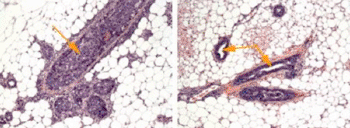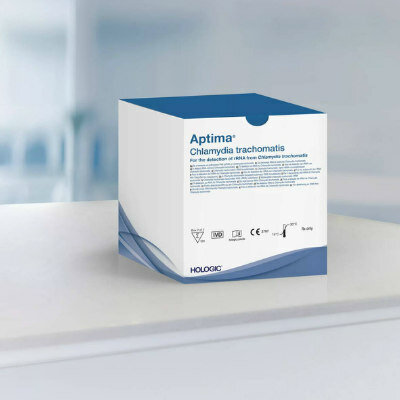MicroRNA Treatment Prevents Breast Cancer in Mouse Model
By LabMedica International staff writers
Posted on 15 Jan 2014
Mice that had been genetically engineered to develop breast cancer were protected from the disease by injections of nanoparticles containing a specific microRNA (miRNA) directly into their milk ducts. Posted on 15 Jan 2014
Investigators at Harvard University Medical School (Boston, MA, USA) were looking for biomarkers to better identify and treat breast lesions at the earliest possible stage of development. Working with transgenic C3(1)-SV40TAg mice, they used computational gene network modeling to identify the HoxA1 (Homeobox A1) protein as a putative driver of early mammary cancer progression. Previous studies had shown the HOXA1 gene was repressed by the microRNA miR-10a.

Image: Milk ducts in cancer-prone mice are packed with tumor cells (deep purple cells, shown by arrow), causing the ducts to grow fatter. However, milk ducts in mice treated with a gene-silencing nanoparticle remain mostly hollow (right, shown by arrows), like healthy ducts (Photo courtesy of Dr. Amy Brock, Harvard University Medical School).
MicroRNAs (miRNAs) are a small noncoding family of 19- to 25-nucleotide RNAs that regulate gene expression by targeting mRNAs in a sequence specific manner, inducing translational repression or mRNA degradation, depending on the degree of complementarity between miRNAs and their targets. Many miRNAs are conserved in sequence between distantly related organisms, suggesting that these molecules participate in essential processes. In fact, miRNAs have been shown to be involved in the regulation of gene expression during development, cell proliferation, apoptosis, glucose metabolism, stress resistance, and cancer.
The investigators hypothesized that the progression of breast cancer could be blocked by RNA interference (RNAi) therapy and set out to develop a targeted therapeutic delivery strategy. Initially, they found that silencing the HOXA1 gene in cultured mouse or human mammary tumor spheroids resulted in increased lumen formation, reduced tumor cell proliferation, and restoration of normal epithelial polarization.
When the HOXA1 gene was silenced in vivo via intraductal delivery of nanoparticles loaded with miRNA through the nipple of transgenic mice with early-stage disease, mammary epithelial cell proliferation rates were suppressed, loss of estrogen and progesterone receptor expression was prevented, and tumor incidence was reduced by 75%. These findings were published in the January 1, 2014, online edition of the journal Science Translational Medicine.
"The findings open up the possibility of someday treating patients who have a genetic propensity for cancer, which could change people's lives and alleviate great anxiety," said senior author Dr. Don Ingber, professor of vascular biology and bioengineering at Harvard University Medical School. "The idea would be start giving it early on and sustain treatment throughout life to prevent cancer development or progression."
"This work marks a milestone not just in breast cancer research, but in systems biology," said Dr. Ingber. "Combining computational, engineering, and biological approaches has led to a new way to identify drugs that prevent cancer development and progression."
Related Links:
Harvard University Medical School














